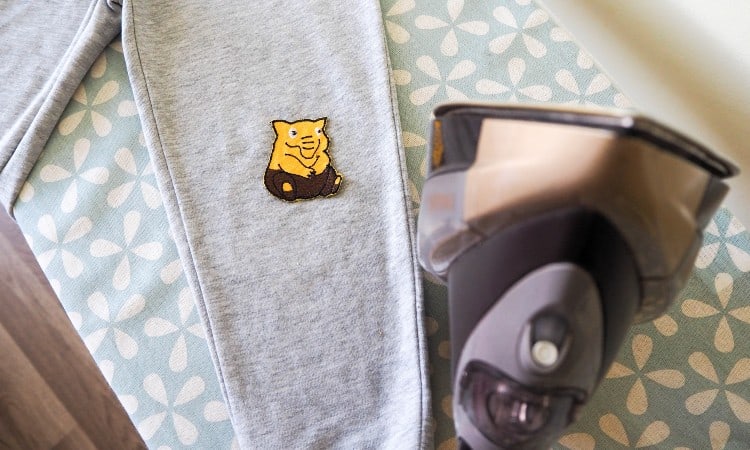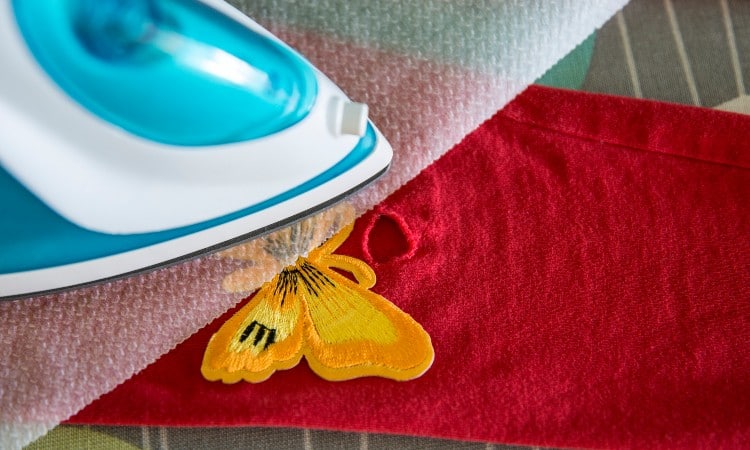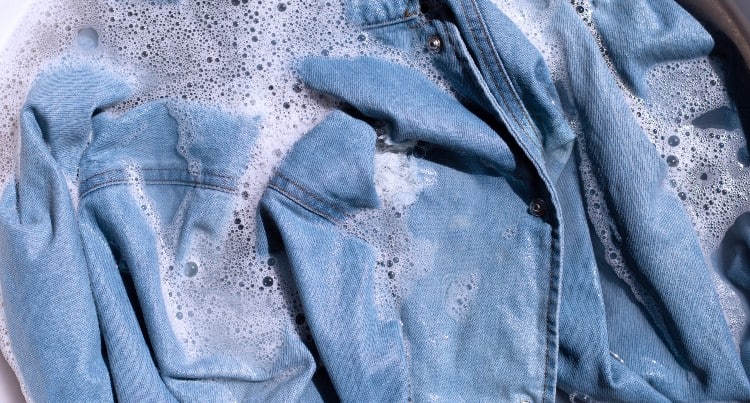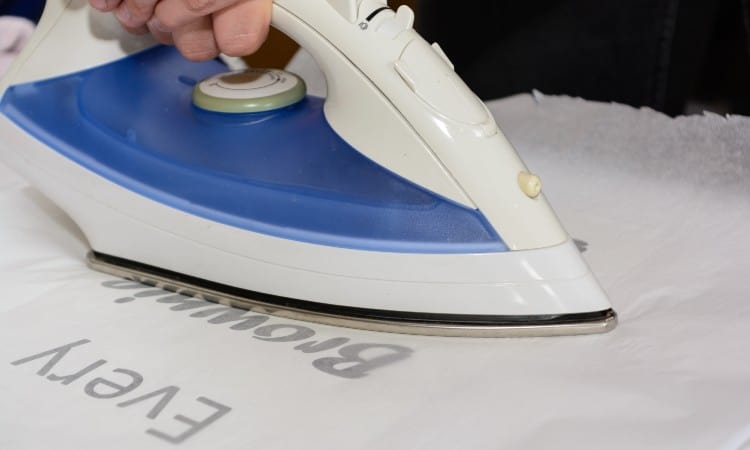Maybe you found an awesome vintage leather jacket at the thrift store, but you don’t like the motorcycle patches glued all over it. Or perhaps you have outgrown some of your favorite bands from years ago and want to take the old embroidered patches off your favorite shirt. Either way, you can learn how to remove iron-on patches without damaging your clothing!
The best way to remove iron-on patches is to use a careful application of heat by applying an iron or hairdryer to remelt the adhesive. Other popular methods include freezing the patch to make the adhesive brittle. Finally, adhesive removers can dissolve the glue holding the patch in place.
In this article, you will learn seven easy methods for removing iron-on patches. You will find tips for how to handle iron-on vinyl as well. Finally, you will discover how to handle patches on special clothing like a leather jacket.

Quick Navigation
Do Iron-On Patches Come Off?
Iron-on patches can come off fabric if the adhesive holding the patch gets too hot or if an adhesive remover dissolves the old glue. Actually, patches can come off on their own if the garment gets too hot. Putting a jacket covered in patches in the dryer, for instance, could cause the badges to peel up at the edges or even fall off!
That said, embroidered patches come with a pretty strong heat-activated adhesive backing these days. Most patches use a kind of double-sided fusible web that has lots of sticky fibers to hold your patch in place.
If a badge is correctly applied by heating the surface of the badge and then eating the fabric on the reverse side as well, a badge will stick in place pretty much permanently.
In these cases, you have to intentionally remove the patch using either heat or chemicals.
Can You Remove Iron On Patches?
You can remove iron-on patches by using either a re-application of heat or special chemical solvents. In some cases, you can also use extreme cold to make the adhesive brittle enough to remove easily.
You might want to remove iron-on patches for many reasons, such as saving old patches as keepsakes or upcycling a garment you found at a thrift store. Before you start ripping the patches, though, you should consider a few factors.
First, what fabric is the garment, bag, or item made out of? You can pretty easily get a patch off denim, leather, or thick polyester, but more delicate materials may fall apart or rip during the removal process.
Also, you should consider how the item will look without the patch. Chances are pretty good that the patch has remained on that fabric for a while, meaning that the fabric behind the patch will look a lot less faded than the rest of the garment! This means that if you take off a star-shaped patch from a denim jacket, you will have a dark blue star and faded denim around it!
Finally, most of the patch removal methods you will find here tend to leave a stiff layer of adhesive on the garment. You can get rid of the dried adhesive using special chemical solvents, but these could damage the fabric. Make sure you spot-test the adhesive remover on a hidden section of the fabric item or garment to ensure it is safe to use!
How to Remove Iron on Patches: 7 Methods
You can remove an iron-on patch with surprisingly little trouble by trying one of these seven simple methods! Heat, cold, or strong chemicals can all release the grip of the original adhesive holding the embroidered badge in place.
Before you begin, think about necessary safety precautions! If you use a hot iron, don’t touch the badge with your bare hands–use a glove or a pair of tweezers. If you use storm chemicals, make sure you don’t get them on your skin!
1. With an Iron

The most popular method for removing an iron-on badge is to use an iron. This method usually offers you the most immediate results. The only danger is that you should not use a hot iron on certain types of fabric to avoid melting or scorching them.
You may find this counter-intuitive since you probably used the iron to put the badge on in the first place! But when you think about it, the heat made the glue melt the first time, and it can also make it melt again for a second time!
Before you begin, find out what kind of fabric the patch is stuck to. Cotton fabrics like denim can handle high heat. Leather or polyester will need low heat settings.
- Start by setting up your ironing board and heating your iron to the highest temperature your fabric can handle. You do not want to activate the steam setting, though.
- Next, smooth either a thin pressing cloth or a piece of wax paper over the top of the badge. A handkerchief or thin kitchen towel will also work.
- Press the iron down firmly on top of the pressing cloth for fifteen seconds.
- Set the iron aside and remove the pressing cloth. Use your fingers or a pair of disposable tweezers to gently tug at the edge of the badge. Does it peel up easily?
- If the badge does not release easily, replace the pressing cloth and heat again for 15 seconds.
- Once the patch glue melts, use the tweezers or your fingers to tug the badge away from the fabric.
- You will probably see a scrum of old adhesive left on the fabric’s surface. Don’t worry about this! You can find tips for removing it later on in this article.
2. Without an Iron – Nail Polish Remover
 One of the cheaper methods for removing an iron-on patch is to use nail polish remover that contains acetone. Acetone can dissolve many types of adhesives, making it an excellent, affordable choice for this project!
One of the cheaper methods for removing an iron-on patch is to use nail polish remover that contains acetone. Acetone can dissolve many types of adhesives, making it an excellent, affordable choice for this project!
You should spot-test a drop of the nail polish remover on a hidden inner seam and let it sit for fifteen minutes. Check and make sure you don’t see any discoloration on the fabric before proceeding.
- Dip a cotton ball in nail polish remover and dab it repeatedly at the edge of the badge.
- Use tweezers to ease up the badge’s edge as it begins to loosen.
- Soak another cotton ball and slide it under the badge.
- Keep going as you peel the badge up and apply acetone to the folded edge.
- Once the badge comes off, set it aside and use a fresh cotton ball soaked in nail polish remover to wipe across the remaining glue residue until it dissolves and comes away.
3. Warm Water Soak

Not every iron-on patch will come off in warm water, but older patches that already look loose may just need a hot bath!
Please note that you should not try this method on leather. Make sure you can safely submerge the item or garment in water before trying the soaking technique!
- To begin, fill a bucket with warm water.
- Lower the item with the patch on it into the water. For a bulky garment like a jacket, set the portion with the badge in first so that the rest of the garment can hold it down. You can also use a clean glass jar or other waterproof weight to hold the badge down beneath the surface of the water.
- You will want to let the iron-on patch soak for at least three hours, but keep checking the water. As soon as it turns to room temperature, empty the water and replace it with new, warm water.
- After three hours, drain away or dump out the water.
- Gently peel the badge away from the fabric. If it doesn’t come away instantly, you may have to work it back and forth, tugging gently.
4. Freezer
Another way to change the temperature dramatically and alter the state of the glue holding your patch in place is to freeze it! When the adhesive freezes, it will usually become more brittle and easy to break.
Of course, for this method to work, the garment or item with the patch on it must fit in your freezer! A bulky winter coat or large backpack may not fit. In that case, simply try a different method!
- Place the garment or item inside a plastic trash bag. Set it in your freezer.
- You can set a timer for two to three hours or simply leave it in there overnight!
- Before taking it back out of the freezer, set up a flat place to work, like a table or counter. Have a blunt spoon handy. You don’t want to use anything sharp like a craft knife since that could slice the fabric beneath the badge.
- Take the garment out of the freezer. Immediately go to work on the edge of the badge, trying to slide the blunt spoon underneath the edge. In most cases, the brittle adhesive will crack and the badge should pop free!
- You will need to use an adhesive removal method to get the remaining flakes of glue up once the badge is gone.
5. Hair Dryer
If you don’t have an iron at home, you can also use a hairdryer to heat the adhesive behind an iron-on badge and remove it!
This method can also work well if you have a bulky item that you can’t easily iron, like a backpack.
- If you can, lay the garment or item flat with the badge facing down so you can access the material behind it. If you can’t do this, find a way to access the reverse side of the badge, such as reaching inside a backpack.
- Turn your hairdryer on using the hottest setting you can.
- Hold the dryer so that the hot air hits the reverse side of the patch, heating the fabric behind the badge.
- Keep it here for fifteen seconds, and then try peeling up the edge of the patch. If it comes up, keep gently peeling! If it does not, use the hairdryer again for another fifteen seconds.
- Once you get the badge off, you will probably need to use an adhesive remover to get any remaining stickiness off the surface of the fabric.
6. White Vinegar
 For a chemical-free, no-heat-required method, consider using white vinegar! Vinegar will not dissolve adhesives as effectively as acetone, it is true. But if you want a gentler method and have a bit of time to spare, give this technique a try!
For a chemical-free, no-heat-required method, consider using white vinegar! Vinegar will not dissolve adhesives as effectively as acetone, it is true. But if you want a gentler method and have a bit of time to spare, give this technique a try!
- Fill a bucket one-third full of water. Add the same amount of white vinegar, and swish it around to mix the solution.
- Add the item that has the patch on it. Make sure it sinks completely under the water.
- Let this soak overnight or for at least 12 hours.
- After the soak, take the item out of the water and use a spoon, credit card, or blunt butter knife to pry at the edge of the patch. If it peels away even a little, keep going! Working gently but firmly, you should get the badge all the way off with careful prying.
- You may need to use another method to get any remaining adhesives off the fabric once you have the badge removed.
7. Glue Remover
 A commercial adhesive remover also offers an efficient way to get a stubborn patch off your clothing or bag. The downside is that you have to buy a special commercial product, such as Goo Gone.
A commercial adhesive remover also offers an efficient way to get a stubborn patch off your clothing or bag. The downside is that you have to buy a special commercial product, such as Goo Gone.
The added benefit here is that you can also use the product to get any lingering adhesive off the fabric after the badge comes off!
Popular commercial adhesive removers include Goo Gone, Elmer’s Sticky Out, Uni Solve Wipes, 3M Adhesive Cleaner, and many more!
To use the product, simply follow the instructions on the packaging. For instance, some products may require that you leave the item to sit for a few minutes, while others may work instantly.
What is the Easiest Way to Remove an Iron-On Patch?
The quickest and easiest way to remove an iron-on patch is to use the iron method, reheating the adhesive so that it becomes tacky and allows you to easily pull off the old patch.
That said, some bulky garments or items may prove challenging to iron. In these cases, you can try using a hairdryer for better access.
Using heat usually works most quickly to get a badge off. But this process often leaves a sticky residue on the fabric’s surface. To treat that, you will also need a glue remover like acetone or a commercial product like Goo Gone.
Can You Remove Iron-On Vinyl?

Removing iron-on vinyl is not as easy as removing an iron-on patch, but you can do it with the help of an iron, a knife, and a pair of tweezers.
- Start by heating your iron to its hottest setting. If you have a heat press, use that instead! You should not have to worry about damaging the fabric since whoever put the vinyl on first had to use heat to get it there as well!
- Next, set up the garment or item so that you can press the iron to the reverse side of the vinyl. You want to iron the fabric, not the vinyl itself.
- Press the iron to the material behind the vinyl for ten to twenty seconds.
- Quickly remove the iron and flip the fabric over so that you can immediately start to pry at the edge of the vinyl using your knife. It may come off in flakes at first, but hopefully, chunks of vinyl will come off after you get started!
- If nothing happens, you will have to heat the back of the fabric again and then try to pry at the edges.
How Do You Get Patch Adhesive Off Clothes?
You can get patch adhesive off clothes in several ways, including using a commercial glue remover, acetone, or your freezer.
Commercial adhesive removers will come with instructions. These will tell how to apply the product and how long to let it sit, and whether or not you need to wash the item to remove the remover after!
If the adhesive remover of your choice seems not quite strong enough, try using an old toothbrush to scrub at the old glue. Then rinse everything away and apply laundry detergent to the sticky spot before washing it in a cold-water cycle.
For a cheaper alternative, you can also use nail polish remover, which contains acetone. In most cases, you can simply soak a cotton ball in nail polish remover and swipe it over the dried adhesive several times, wiping away the old glue.
Finally, you can use the freezer method and chill the old adhesive for a couple of hours. Then use a blunt butter knife to scrape away the remaining glue!
Really strong products like paint thinner, no doubt, could dissolve the badge adhesive as well, but the paint thinner will almost certainly damage the fabric of the clothing or bag.
Tips for Removing Patches from Special Clothing
Now that you know the seven easiest ways to remove an iron-on badge, check out these tips for how to get a patch off special clothing!
Uniform
In some cases, the simplest way to get badges off a uniform without damaging them is to dry-clean the garment. The chemicals used in this process will likely cause old badges to fall off.
If you choose this method, make sure you talk to the dry cleaner to let them know you want the iron-on patches to come off!
You can also use a spray adhesive remover like Badge Magic onto the inside of the badge and on the fabric inside the uniform. Let this sit for fifteen minutes before you try peeling away the patch.
Shirt
Getting an iron-on patch off a shirt usually doesn’t require any special steps. So long as you can safely apply heat to the fabric, you can just use the iron method! This lets you quickly reheat the adhesive and peel the patch away.
If you have a shirt made out of a more delicate material, you should avoid high heat and strong chemicals. In this case, try using the freezer or warm water methods. Besides doing a spot test with the iron on a hidden seam of the shirt, one easy way to determine if your shirt can handle the heat is to check the manufacturer’s label inside. This label will usually have a picture of iron with an X over it if you should not apply heat.
Jacket
Most of the time, you can safely use an iron or a glue remover on a jacket. Khaki or denim jackets, in particular, should hold up well to any of the removal methods in this article. On the other hand, if you have a sportswear or acrylic jacket, you may need to try gentle methods that will not damage the synthetic material.
If you have a badge on a thick, puffy coat, you should probably not try the heat method. Instead, try the warm water soak method, which should not melt the fabric!
Leather
Many cool, old leather jackets come equipped with old motorcycle patches, band logos, or other embroidered patches! If you still like all of the patches, this is a cool decorative element, but if you want to remove them, you will need to take some extra care.
You should not expose leather to water or high heat. This means no iron method, hairdryer method, or warm water soak! Leather could also react poorly to some solvents.
To get a patch off of leather, you can try the freezer method, or you can spot-test a commercial product like Goo gone on a hidden spot to make sure it will not damage the leather. Then use it to gently dissolve the adhesive holding the badge in place, and remove it from the leather!
All of that said, most iron-on patches don’t stick well to leather to begin with. For this reason, you will more often find patches sewn onto leather rather than attached with heat-activated adhesive.
Denim
Getting iron-on patches off denim is generally pretty easy. Denim is made of cotton, so you can safely get it wet, heat it, or apply many commercial adhesive removers.
That said, denim does fade a lot, so you may find obvious patch-shaped blobs on your denim after removing the badges. There is not much you can do about this except applying new patches to hide those spots!
Conclusion
You can remove iron-on patches from most types of fabric using heat, either form an iron or from a hairdryer. Another easy way to get a patch of fabric is to apply either nail polish remover containing acetone or use a commercial glue remover such as Goo Gone to dissolve the old adhesive. If you don’t want to use heat or chemicals, you can also use a warm water soak or put the clothing in your freezer and then snap the badge off!
If your patch is attached to leather or delicate material, you may need to work carefully. For a patch on leather, try spot-testing a commercial glue remover and using that to loosen the badge. For more delicate fabrics, you may want to start with a warm water soak overnight to see if that will loosen the patch.